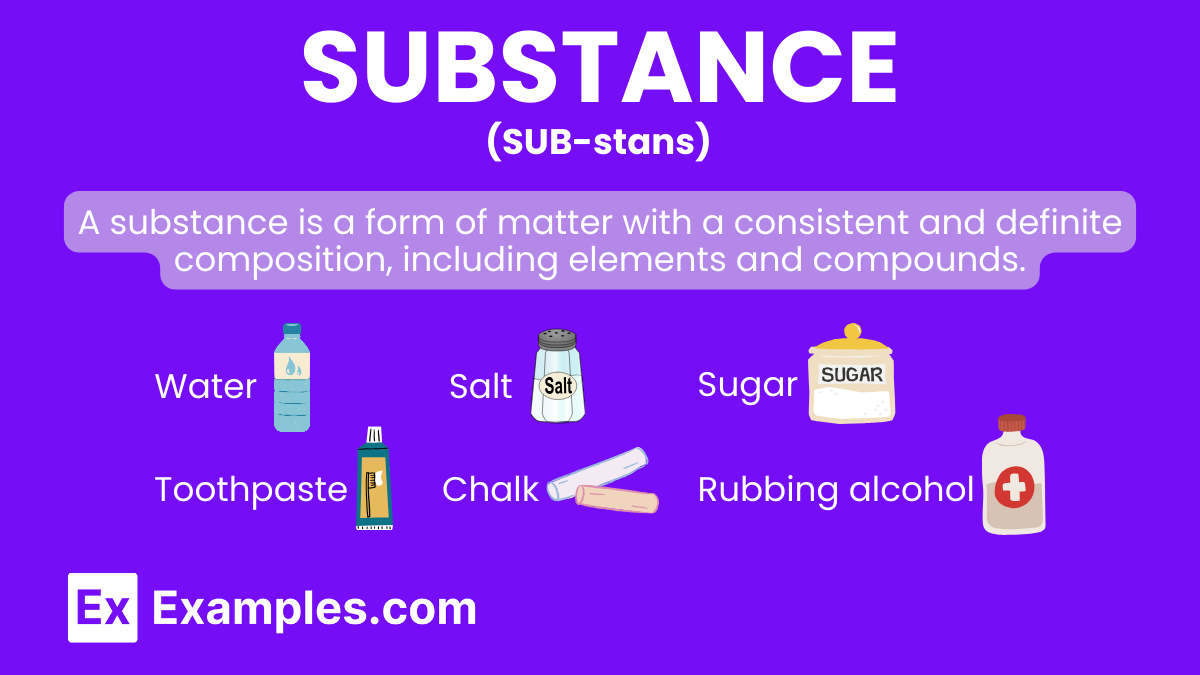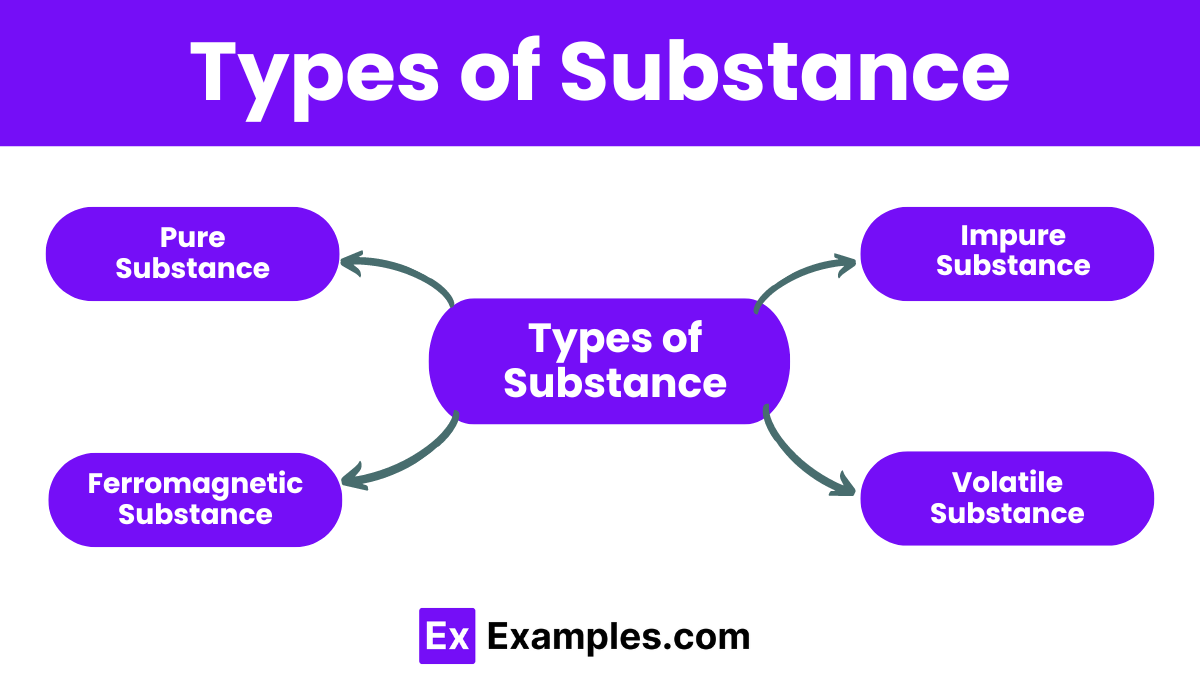Which of the following is an example of a pure substance?
Saltwater
Air
Gold
Milk


In chemistry, a substance is any form of matter that has a uniform and unchanging composition. This means that a substance is made of the same material throughout and has specific properties that do not change. Examples of substances include water, salt, and sugar. Each of these has a distinct chemical makeup and set of characteristics that define them. Understanding substances is fundamental in chemistry because it helps us identify and classify different types of matter in the world around us.
The formula of a substance clearly shows the elements it contains and the ratio of these elements. For instance, the formula H₂O indicates that each molecule contains two hydrogen atoms and one oxygen atom. Similarly, the formula CO₂ shows that each molecule has one carbon atom and two oxygen atoms. NaCl means each molecule consists of one sodium atom and one chlorine atom. These formulas help identify the composition and proportion of elements in a substance, providing a clear and concise representation of its makeup.

A pure substance consists of a single type of element or compound with a uniform and definite composition. It has consistent physical and chemical properties throughout. For example, pure water (H₂O) has the same composition and properties regardless of the sample size or source. Pure substances cannot be separated into other kinds of matter by physical means like filtration or distillation.
Pure substances are categorized into elements and compounds. Elements contain only one type of atom, such as gold (Au) or oxygen (O₂), while compounds are composed of two or more types of atoms chemically bonded together, like carbon dioxide (CO₂) or sodium chloride (NaCl). The purity of a substance is crucial in scientific experiments, industrial processes, and the manufacturing of pharmaceuticals to ensure consistent and reliable results.
An impure substance, or mixture, contains two or more different components that are not chemically bonded and can be separated by physical methods. These components retain their individual properties and can vary in proportion. For instance, a mixture of salt and sand is an impure substance because it contains two distinct materials that can be separated through filtration or sieving.
Impure substances are further classified into homogeneous and heterogeneous mixtures. Homogeneous mixtures, like saltwater, have a uniform composition throughout, while heterogeneous mixtures, like a salad, have visibly different components. Impurities can affect the properties and behavior of a substance, making the study and management of impurities important in fields like chemistry, environmental science, and quality control.
Ferromagnetic substances exhibit strong magnetic properties due to the alignment of their atomic magnetic moments in the same direction. These substances, such as iron (Fe), cobalt (Co), and nickel (Ni), can be magnetized to become permanent magnets. The unique behavior of ferromagnetic materials is a result of their crystal structure and the presence of unpaired electrons, which create a net magnetic moment.
In ferromagnetic substances, the magnetic domains, which are small regions with aligned magnetic moments, combine to form a strong overall magnetic field when exposed to an external magnetic field. This alignment can persist even after the external field is removed, making these materials essential in various applications, such as in the manufacturing of electric motors, transformers, magnetic storage devices, and other technologies relying on strong, stable magnetic fields.
Volatile substances readily vaporize at low temperatures due to their high vapor pressures. This property means they can easily transition from a liquid or solid state to a gaseous state. Examples of volatile substances include alcohol, acetone, and gasoline. The volatility of a substance is influenced by factors like molecular weight, intermolecular forces, and temperature.
Volatile substances are crucial in many industries and applications. In perfumery, they are used to create fragrances that quickly disperse into the air. In the chemical industry, volatile solvents are used to dissolve other substances and then evaporate, leaving behind the desired product. However, handling volatile substances requires caution as they can pose health risks through inhalation and may also be highly flammable.

| Characteristic | Pure Substances | Impure Substance ( Mixtures ) |
|---|---|---|
| Definition | Consist of only one type of element or compound with a uniform composition. | Consist of two or more different substances physically combined. |
| Composition | Fixed and definite. | Variable and can change. |
| Physical Separation | Cannot be separated into other substances by physical means. | Can be separated into individual components by physical means. |
| Chemical Bonds | Elements or compounds are chemically bonded. | No chemical bonding between the components. |
| Properties | Uniform and consistent throughout. | Retain the individual properties of their components. |
| Examples | Water (H₂O), Oxygen (O₂), Sodium Chloride (NaCl) | Saltwater, Air, Salad |
| Classification | Divided into elements and compounds. | Divided into homogeneous and heterogeneous mixtures. |
| Melting and Boiling Points | Have specific, sharp melting and boiling points. | Have a range of melting and boiling points depending on the composition. |
| Homogeneity | Always homogeneous. | Can be homogeneous (uniform composition) or heterogeneous (non-uniform composition). |
| Purity | Considered pure. | Considered impure. |
A substance is any form of matter with a definite and uniform composition, consisting of elements or compounds with consistent properties.
A substance is considered any material with a uniform and definite composition, such as elements like gold or compounds like water.
Mixtures, such as salad or air, are not considered substances because they do not have a uniform and definite composition.
The simplest type of substance is an element, consisting of only one type of atom, like hydrogen or oxygen.
A substance is something made of one kind of material all the way through, like water or salt, that has its own set of properties.
A pure substance has a uniform composition and specific properties. It can be an element or a compound, like distilled water.
Someone with substance is a person with depth, integrity, and strong character. They possess meaningful qualities and contribute positively to their surroundings.
A pure substance is a material made of only one type of element or compound, having consistent properties throughout.
A substance with only one type of particle is called a pure substance, such as distilled water or pure gold.
A substance made of the same type of atoms is called an element, like helium or iron.
Text prompt
Add Tone
10 Examples of Public speaking
20 Examples of Gas lighting
Which of the following is an example of a pure substance?
Saltwater
Air
Gold
Milk
A mixture is defined as:
A substance with a definite composition
A combination of two or more substances that are not chemically combined
A substance with variable composition
A substance that cannot be separated into simpler substances
Which of the following is a homogeneous mixture?
Salad
Sand and water
Vinegar
Oil and water
What is the term for a substance that cannot be broken down into simpler substances by chemical means?
Compound
Mixture
Solution
Element
Which of the following is a chemical property?
Reactivity with acid
Density
Melting point
Boiling point
Which process can be used to separate a mixture of salt and water?
Filtration
Evaporation
Chromatography
Distillation
Which of the following is a heterogeneous mixture?
Saltwater
Blood
Sugar solution
Brass
What is a compound?
A mixture of two elements
A substance that can be separated into its elements by physical methods
A pure substance composed of only one type of atom
A substance made of two or more elements chemically combined
What property of a substance is measured in grams per cubic centimeter (g/cm³)?
Volume
Density
Mass
Temperature
Which of the following is an intensive property of a substance?
Mass
Volume
Length
Density
Before you leave, take our quick quiz to enhance your learning!

